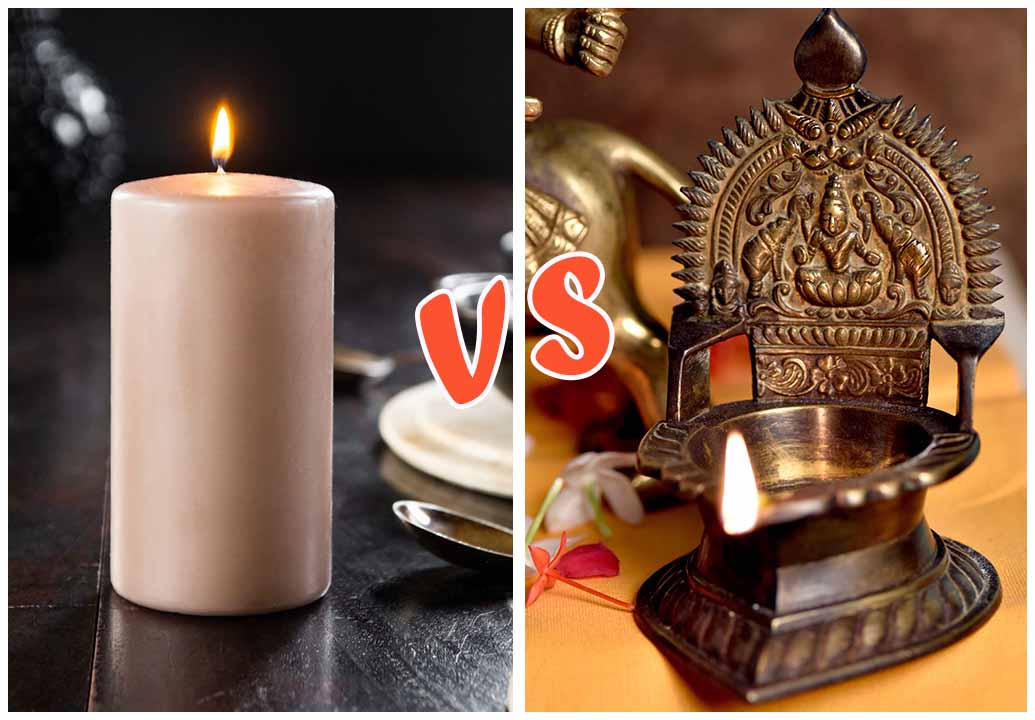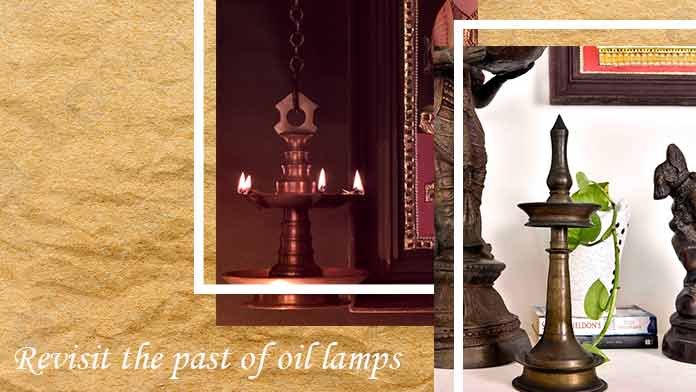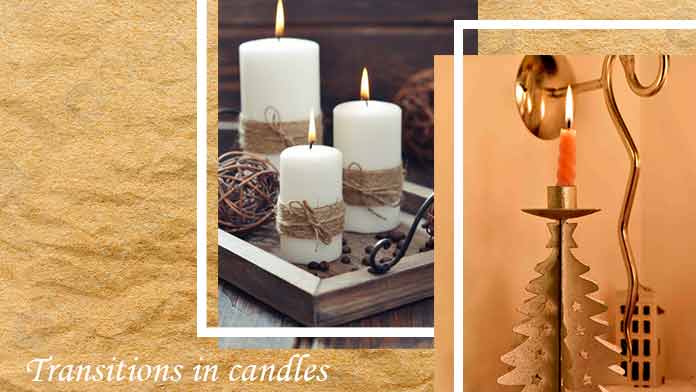Candles and oil lamps have both been in use for ages to illuminate homes and dwelling grounds. Today we will cover the history of both, discover the different varieties of candles and oil lamps that sell today and also find the difference between both the items.

Oil lamps
Oil lamps, as the name indicates, use oil as a fuel to produce light. The effect is awesome and electrifying! There is a rich long history behind the use of oil lamps. Today, the Brass oil lamps may not be quite regularly used but when they are – during festivities or power-cuts – the bright illuminated light is enough to fill you with joy and amazement for a long time to come. There are candles too that get used as an alternative to electric lights during events and outages, but the rich royal past of the oil lamps and many other features make them a better choice vis-a-vis wax-made candles.
Going down the lane to revisit the past of oil lamps
The first known oil lamps were used in the Chalcolithic Age – these lamps Diya were made pottery-made and roundish in shape.

- Oil lamps arrived full-fledged on the scene some 4,500 years back – the first discovered proof was in ancient Mesopotamia – the lamps were lighted using olive oil. Much later, it was sesame oil that started being used in this region for lighting the lamps.
- In some parts of Northern Europe, it was fish and whale oil that served as fuel for the lamps.
- In some other parts of the world, the earliest form of oil lamps was made from shells of eggs and coconuts; or even seashells. The oil would be animal fats.
Before the advent of electricity, it was the oil lamps that served as the source of light for umpteen numbers centuries.
Transition in design and shapes from then to now
The creative talent of man gets showcased amply with the different designs of oil lamps that were made and used through different periods and centuries. The earliest known designs were rounded shaped lamps that transitioned into oil lamps made from coconut shells or eggshells. Much later, stones were carved to make saucer-shaped lamps, which eventually led to the innovation of the nozzle that got added to the oil lamp to offer the wick a stable standing ground.
Centuries later it was the genie lamps with the closed base and sprout oil lamps that were popularly used in homes. To prevent the flame from dying down due to wind, gave rise to the discovery of the chimney that was usually made of glass and helped cover the flame. These were the ones that were similar to what we get to buy for our homes today.
Oil lamps that help enhance the decor of the indoors
Clay lamps - The saucer-shaped lamps have been in use since the Bronze Age. Today, different variants of the same are seen being used during festivals in India – especially Diwali, the Festival of Lights. Metallic lamps are intricately designed and showcase the craftsmanship of metalworking techniques.
Some of the oil lamp varieties that are very popular in India today include – brass made peacock Diya lamps, handmade flower-shaped brass oil lamps, Akhanad Brass oil diyas, Swastika oil lamp, square-shaped carved brass oil lamp, heart-shaped brass oil lamp, lotus oil lamp, thooku vilakku, gajalakshmi vilakku oil lamp, and the nilavilakku oil lamp are all different varieties of oil diyas and lamps. These oil lamps are used primarily in the deity room or the prayer room in Indian households and also grace festive and pious occasions.
Candles -
A candle is made of wax and has a wick that when lighted melts the wax and spreads light around. Before candles made an entry into the illumination space, people used oil lamps as a source of light.
A sneak into the past
The ancient candles were made from fallow – these were very common in the Middle Ages. The other materials used to make candles back then were natural fat, and also wax.
Beeswax candles followed much later and immediately became a hit because it had clearer and cleaner smoke. However, these were expensive and only the rich could afford. It was only in the 19th century that mass production of candles begun. This was the time when paraffin wax was introduced. Later on, with the launch of kerosene lamps, the popularity of candles went down.
Designs and transitions in candles from then to now
Today, we get to buy different types of candles, designed to enhance the look and feel of the place. Some of the common types of candles that you can easily afford and buy today include – votive candles where the wax is placed in a glass container of different shapes; pillar candles are long and bulky, round or square, and are designed exotically to lend a spectacular look to the place; taper candles are the conventional candle that most homes keep handy to burn during outages. In the last few years, there has been a revolution in the candle industry – ever since the scented candles have made way into our living rooms and bedrooms. And, finally, the creatively designed décor candles that have hit the market in recent times are made with attractive and colourful designs to notch-up the glamour of our homes and workplaces.

With ongoing innovations and researches, some additions are being made in the gamut of candles – there are soy and vegan candles, the smokeless, and sustainable candles that are now available for customers to buy and add warmth to their place.
Comparing oil lamps with candles
Both are ubiquitous and both the types look extremely attractive gracing the indoors. Be it the oil lamps or the candles, you can create a soul-stirring ambiance at home using either of these items. However, there are certain advantages of the oil lamp over the candles that you might want to compare when picking one or the other.
Costs - Using an oil lamp can work out cheaper than candles, depending upon the oil; that you use as the fuel.
Reusability – Candles as we all know are meant for one-time use. The wax melts till the candle finally diminishes to nothing. Oil lamps usually stick by for a longer period some varieties are so robust that they can be passed on from one generation to another.
Cleaning – You need to spend time cleaning both. While with the candle, it is the wax removal process from the tables, floors, or any other surface; oil lamps need cleaning of the oil container, the wicks, the chimney, and other parts to maintain the item.
Waste – Wax dropping and the residue is a waste from a candle, while in most oil lamps the process of burning of the fuel is such that even the last drop of oil is burnt effectively.
Designs - Be it candles or oil lamps, there are different designs of both.
Technical features – The flame in the case of oil lamps can be controlled by man. In the case of a candle, you cannot do so. Also, the flame of the oil lamps is at a constant height; with candles, the flame height moves down as it burns out.
Risks – Due to the flame, there are fire risks with both of these items though oil lamps being covered are safer than candles.
It is observed that using candles made using natural alternatives to paraffin wax like soy ones can be a good idea. Similarly, coconut wax also works the best for you however, it can be quite expensive. Yet the same has a great scent throw and is designed in an eco-friendly fashion.
Besides wax, the scent itself will affect the room and its quality. For instance - if you love scents like pumpkin, apple, etc. then you can enjoy these strong-smelling candles in these spicy blends.
However, if you wish something that lasts for almost all year round then you surely need to choose enticing fragrances like jasmine, sandalwood, etc. These can be smelled from each room to another. It is important to seek advice from your friends and family to ensure that you have the best results. Likewise, due care must always be exercised to ensure the best outcomes for your home.










